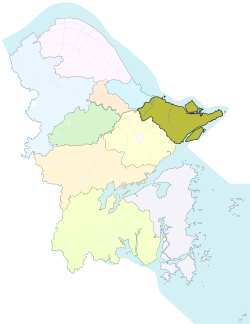Beilun District
| Beilun 北仑区 | |
|---|---|
| District | |
|
Clockwise from the top: Port of Ningbo, Yanshan Dyke, Zhonghe Road Station, China Port Museum, Chuanshan Wind Power Plant | |
 Beilun District in Ningbo Municipality | |
 Ningbo in China | |
| Country | China |
| Province | Zhejiang |
| Prefecture | Ningbo |
| Area | |
| • Total | 599.03 km2 (231.29 sq mi) |
| Population (2008) | |
| • Total | 380,100 |
| • Density | 630/km2 (1,600/sq mi) |
| Time zone | China Standard (UTC+8) |
| Postal code | 315800 |
| Area code(s) | 0574 |
| Website | http://www.bl.gov.cn/ |
![]() Beilun District (simplified Chinese: 北仑区; pinyin: Běilún Qū; Wu: Poh-len Chiu) is a district of Ningbo in Zhejiang province, China. It is dominated by Beilun port, an international port off the easternmost edge of the southern coast of Hangzhou Bay. It primarily services the regional city of Ningbo.
Beilun District (simplified Chinese: 北仑区; pinyin: Běilún Qū; Wu: Poh-len Chiu) is a district of Ningbo in Zhejiang province, China. It is dominated by Beilun port, an international port off the easternmost edge of the southern coast of Hangzhou Bay. It primarily services the regional city of Ningbo.
Beilun port
Originally a small fishing town, the presence of a deep sea lane with year-round minimum depth of 17 meters stretching along the coast of Beilun motivated the Chinese Government to build one of the nation's largest deep sea port here. The port is further protected from storms by the mountainous islets of Zhoushan just off the coast of Beilun.
14.31 billion yuan has already been invested in the Beilun port. With the completion of the Hangzhou Bay Bridge in 2008, Beilun is set to receive increased volumes of international freight and be more closely tied to the metropolis of Shanghai. It has been proposed that Beilun port be managed by the Shanghai port authority. That would have been a logical move given that Shanghai's own port and water lane - a mere 11 metres deep - can only accommodate container ships and freighters of 50,000 tonnes deadweight (DWT) or less. Swift and dangerous undersea currents in Shanghai contribute to an inefficient port that costs the city a great deal to keep open, and even then it is often only usable during high tide. Beilun is also home to a small free trade zone that has a concentration of manufacturers focused on vacuum formed packaging and an older plant that manufactured window air conditioners for Fedders.
Guodian Beilun Power Station, one of the world largest coal power stations, is installed in Beilun's Xinqi town, and managed by the national SOE China Guodian Corporation. Built in two phases, starting in 1988 with a loan from the World Bank, with main equipment imported from France and Japan.
Nature
While much of the district is highly developed, it also contains some forested hilly areas. These are home to Chinhai Spiny Newt, which are unique to the area.[1] One population is within the Ruiyansi Forest Park.[2]
External links
References
- ↑ Xie Feng; Gu Huiqing (2004). "Echinotriton chinhaiensis". IUCN Red List of Threatened Species. Version 2012.2. International Union for Conservation of Nature. Retrieved 23 December 2012.
- ↑ Sparreboom, Max; Wu, Yunke. "Echinotriton chinhaiensis (Chang, 1932)". Salamanders of China LifeDesk. Retrieved 23 December 2012.
Coordinates: 29°55′25″N 121°50′02″E / 29.9236°N 121.834°E
